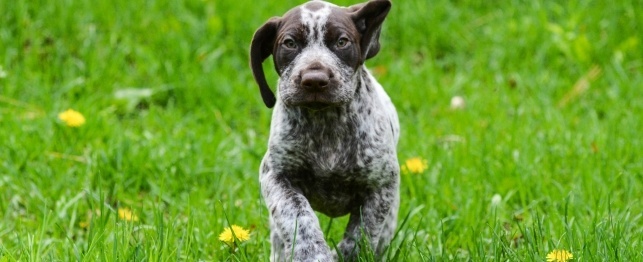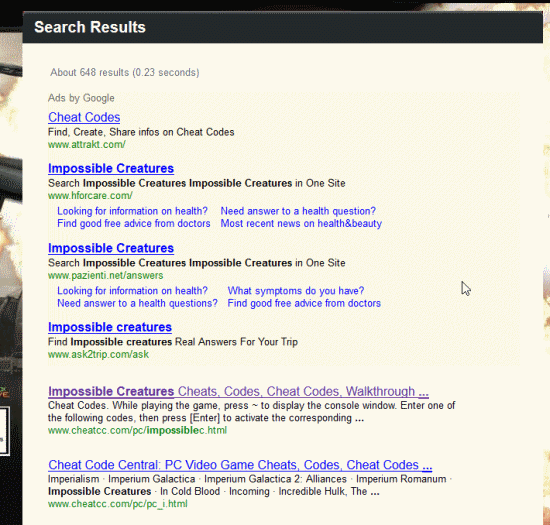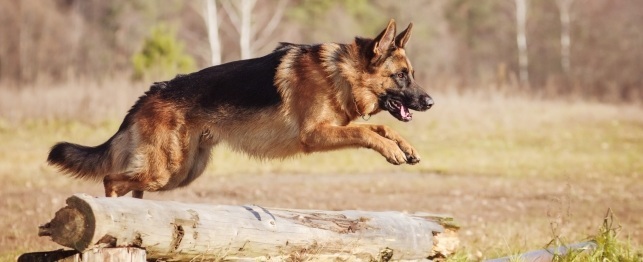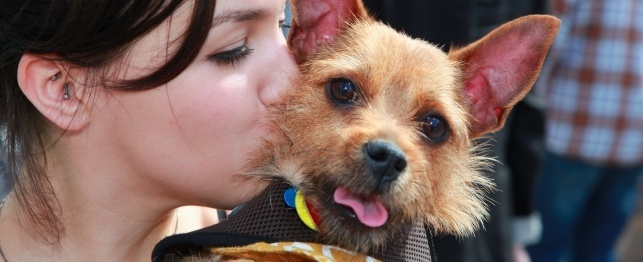AMAZING AUSSIE INSPIRES BOOK, PLAY AND ADVOCACY
Australian Shepherd Pete has never seen a sheep or heard a whistlehe was born blind and deaf. But this gentle, cock-eared pooch has tackled a lifetime of challenges, and Pete's fearless spirit has inspired a children's book and a play. A four-legged symbol of success over adversity, he has traveled to promote awareness and education about disabilities, as well as advocacy for a unique group of Aussies.
I always believed he was here to do something important," said Linda Verville of Saco, Maine, who, with her husband, Jim, adopted Pete 13 years ago. Pete sees with his heart. Since he couldn't hear the naysayers, nothing held him back."
Just a few months old when they got him, Pete had endured a merry-go-round of surrender, adoption and abandonment before he landed at the West Kennebunk Animal Welfare Society, which placed a call for rescue through a local newspaper article.
At the time," Verville said, we had no children, we owned a home and we had another dog, which were deemed desirable factors for adopting a special needs puppy."
The other dog was Chelsea, a shepherd-husky mix that became Pete's mentor as he learned to navigate home and turf without the benefits of sight and sound. Driven by his sense of smell, Pete learned by poking his nose wherever he could, including the laundry basket, dishwasher, sink and a piping hot pot of spaghetti sauce.
Pete couldn't tell the difference between day and night, so he often wanted to play in the middle of the night. When Chelsea died last year, Pete didn't eat for several days. But he was soon back on track with his signature gaitpaws held high in a slow motion prance, nose in the air to find his way.
Living with Pete has been a challenge," Verville said. He's a playful, 50-pound dog who never outgrew the puppy stage. But the laughter and love he creates far outweigh the hurdles and mishaps. Like most Aussies, he's smart, persistent and looking for a job to do."
Although he's blind, Pete reacts to flickering lights, according to Verville, and he also responds to sound vibrations, so she can get his attention by clapping her hands or stomping on the floor. Verville and her family, which now includes three children, communicate with Pete mostly through touch.
To guide him, they tap him under his chin and hold their hand near his nose so he will follow. A stroke on his side is positive reinforcement for something well done. A hold on the scruff of his neck with a gentle shake means he has done something wrong.
As she watched Pete learn, his and Chelsea's interaction and bond, as well as Pete's unwavering spirit in the face of severe disabilities, inspired Verville. A former teacher, she felt called to tell his story by writing a children's book. For Pete's Sake," with illustrations by Melissa Pelletier of Biddeford, was published in 2002.
Written from Chelsea's point of view, the book chronicles Pete's story from street pup to beloved pet. Chelsea can't understand why Pete bumps into things, steals sandwiches off the table, stumbles on the stairs and doesn't respond to sounds. She learns to understand his disabilities, and grows to admire how he has overcome his difficulties and taught her what really matters in life.
Soon after the book was published, Verville and Pelletier took the canine duo and their message on the road, making presentations at bookstores, schools and hospitals. They designed and created a companion workbook to encourage kids to believe in themselves, reach for the stars and do great things."
Through writing and drawing exercises and a variety of puzzles, the workbook illustrates Pete and Chelsea's journey with a focus on accepting disabilities, developing self confidence, appreciating differences and overcoming challenges.
This month Pete's story will hit the stage in Saco. A play based on Verville's book and written by Deb Landry will be performed for approximately 1,500 students in kindergarten through fifth grade at three different area schools.
About 10 middle school students will perform the parts of the animals, including Pete, Chelsea and Sid the cat, who was not in the book, but added for the play. Sid is the narrator and talks in rhymes," said Landry, who is the founder and director of Crossroads, a nonprofit youth group promoting self esteem, self respect and awareness through the performing arts.
Students will also play the parts of Linda and her husband. The play will be available for purchase and will include a teacher's manual and six scripts.
On the heels of writing her book, Verville inadvertently discovered something she didn't know about Pete. I was searching the Internet about blind, deaf dogs," she said. I knew there were dogs who were blind or deaf, but I didn't know about many who were both blind and deaf like Pete, especially from birth."
But with the click of her mouse, there it was. As she connected with other owners of blind, deaf dogs, she learned that many of the dogs were Australian Shepherds born with a genetic disorder that can cause partial or full blindness, deafness or both.
In simple terms, Aussies born with this disorder are the result of merle-to-merle breeding. Merle refers to a color pattern, not a color by itself. The most common variation is called blue merle, which is actually a black dog with the black broken up into irregularly shaped patches by gray. Merle refers to the gray, or lighter part, of the dog's coat, which can vary from extreme light to very dark.
This coloring is often considered typical of Australian Shepherds. Merle can occur in other colors, such as reddish brown, yellow and fawn. Merle is a dominant gene, so a dog with one copy of the gene (one merle parent) will have partial coat lightening. But when a dog has two copies of the gene (two merle parents) the effect is doubled, resulting in most of the coat being white. The visual defects result from improper development of the eye tissues, while the loss of hearing is attributable to a lack of pigment in the inner ear.
Predominantly white Aussies like Pete are called double merles." Statistically, 25 percent of the pups from two merle parents will be double merles. Another term is lethal whites," which Verville said is controversial because of its negative connotation and history. The term came from ranchers who originally bred Australian Shepherds and also had horses.
In certain types of horses, a lethal white gene results in white foals with blue eyes. These horses are unable to digest food, develop colic and die within a few hours or days. So while this is quite different from what happens with Aussie genetics, Verville is not opposed to using the term. It describes their color and their sometimes tragic fate," she said, referring to the fact that some of these dogs are euthanized or don't get adopted because of their disabilities.
Verville discovered two groups dedicated to education and awareness about double merles, or lethal whites, as well as promoting fostering and adoption. Aussielads Rescue (www.aussielads.com) and Amazing Aussies Rescue (www.amazingaussies.com) are both in Arizona. Educational information may also be found online at www.lethalwhites.com and www.handicappedpets.com.
Because of what I've learned from Pete, I feel strongly about advocating for all disabled dogs," Verville said. But, of course, I have a special place in my heart for the lethal whites."
Verville admits she is often asked why she focuses on them instead of more adoptable dogs." She said, I'm not advocating to rescue these particular Aussies instead of, or to displace, a 'typical' dog. What I hope is to motivate people to consider adding one of these wonderful dogs to their family.
Having a 'normal' dog in the house when you adopt a disabled dog is very beneficial. It's a wonderful opportunity for the disabled dog to learn from the other dog, as we learned from Chelsea and Pete. These dogs have amazing capabilities, and that's what I'd like to promote, along with awareness and education, support for owners and motivation for people to foster or adopt."
To achieve these goals, Verville is in the planning stages of organizing a race she has named Running with the Big Dogs." She is also contemplating a sequel to her book.
What's the next chapter for Pete? My head never stops percolating with ideas," said Verville. There's a reason why he came into my life."

 Here Comes the Puppy
Here Comes the Puppy
Here Comes the Puppy
Here Comes the Puppy
 Death Worm Tips Requirements
I use this service included in my writing. Your Sims connec
Death Worm Tips Requirements
I use this service included in my writing. Your Sims connec
 Bringing Home an Adult Dog
Bringing Home an Adult Dog
Bringing Home an Adult Dog
Bringing Home an Adult Dog
 Picking a Male German Shepherd for your Family
Picking a Male German Shepherd for your Famil
Picking a Male German Shepherd for your Family
Picking a Male German Shepherd for your Famil
 Tips to Find Your Perfect Match: The Best Rescue Dog
Tips to Find Your Perfect Match: The Best Res
Tips to Find Your Perfect Match: The Best Rescue Dog
Tips to Find Your Perfect Match: The Best Res